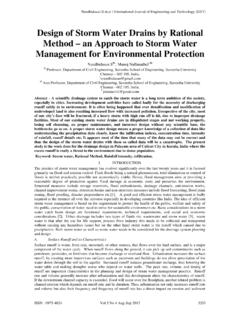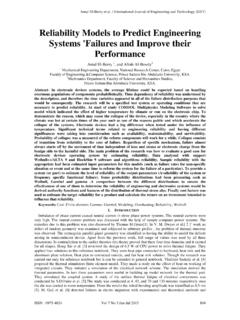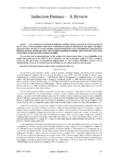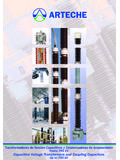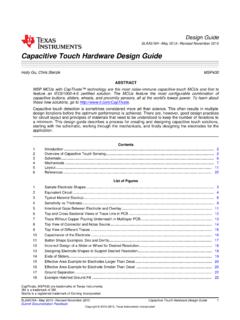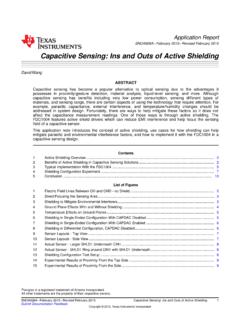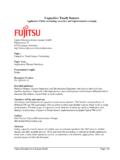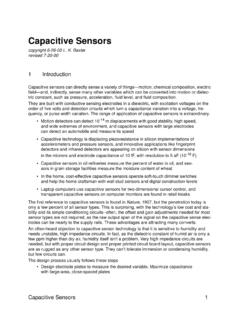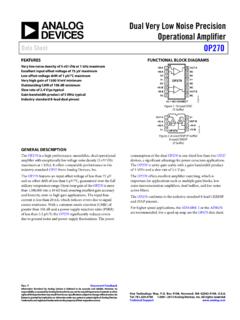Transcription of MEMS Capacitive Pressure Sensors: A Review on …
1 MEMS Capacitive Pressure Sensors: A Review on Recent Development and Prospective Eswaran P1, Malarvizhi S2 1,2 Department of Electronics and Communication Engineering, SRM University Faculty of Engineering and Technology, Chennai, India 1 2 Abstract Recently MEMS Capacitive Pressure sensor gains more advantage over micromachined piezoresistive Pressure sensor due to high sensitivity, low power consumption, free from temperature effects, IC compatibility, etc,. The spectrum of Capacitive Pressure sensor application is increasing, hence it is essential to Review the path of technological development and further prospective of micromachined Capacitive Pressure sensor . This paper focuses on the Review of various types of Capacitive Pressure sensor principle, MEMS materials used in fabrication, procedures adopted in microfabrication for silicon and polymer material diaphragm, bonding and packaging techniques used.
2 Selected result on Capacitive sensitivity, effect of temperature on Capacitive sensitivity was also presented. Finally, the development of smart sensor was discussed. MEMS Capacitive Pressure sensor , Review on Pressure sensor , CDPS, MEMS Fabrication, MEMS Material, Pressure sensor , MEMS (Micro Electro Mechanical System) I. INTRODUCTION A. Overview Day to day the spectrum of Pressure sensor application in medical, aerospace, automobile, industrial and commercial application has drastically increasing. Due to the recent advancement in the microscale fabrication technology micromachined Pressure sensor are being fabricated for the Pressure range from ultra low Pressure to extremely high. At present silicon and polymer material replaces traditional metal diaphragm Pressure sensor .
3 This helps to reduce the material and fabrication cost thereby reduces the product cost/unit. Micromachined Pressure sensor are gaining importance due to its small size, lightweight, integrateable to the IC fabrication process and smart interface features. It also shows high reliability. Piezoresistive, Capacitive , optical, resonance, acoustic transduction principle used in the recent work in the development of micromachined Pressure sensor modeling, design and fabrication was reviewed in [1]. Among these piezoresistive and Capacitive Pressure sensor principle were widely adopted in various works. Many commercialized MEMS Pressure sensor [2-6] uses piezoresistive technique as transduction mechanism from Pressure to change in resistance.
4 Most researchers preferred piezoresistive technique, because the properties of silicon material were well established and the facilities of existing silicon foundry can be used for fabrication in batch production. Piezoresistive Pressure sensor has high gauge factor but it has per C of temperature coefficient of piezoresistivity (TCP). This limits the operating temperature and requires temperature compensation circuit. Micromachined Pressure sensors are fabricated using bulk and surface micromachining techniques [2-3], [6]. High aspect ratio structure is fabricated using bulk micromachining. Surface micromachining is preferred for larger surface area but for few micrometer depth.
5 B. Governing Equation for Diaphragm Membrane Deflections In most of the work; square, rectangle or circular diaphragm structures are used in fabrication. Maximum deflection occurs at the center of diaphragm for built in edges,. Timoshenko gives the differential equation governing the deflection of a plate with uniform Pressure acting normal to the surface in [7]. 44442242wwwPxxyy D ++= (1) The maximum deflection at the centre of a uniformly loaded square plate with built in edges is given by the equation (2). Eswaran P / International Journal of Engineering and Technology (IJET)ISSN : 0975-4024 Vol 5 No 3 Jun-Jul 2013 (2) and, 3212(1)EhDv= (3) Where w is deflection at point of (x, y) coordinates, P is the differential Pressure between two sides of a diaphragm, D is flexural rigidity, a is the length of diaphragm, E is young modulus, is Poisson s ratio and h is the thickness of the diaphragm.
6 The centre deflection of circular diaphragm is given as 24()164 ParwrDa = (4) Where ()wr is deflection at radial distance r from the center of diaphragm, a is radius of the diaphragm. Design and fabrication of Pressure sensor with competitive price plays important role in the product development cycle. To reduce product cost/unit, Pressure sensor designer has to optimize in the areas of material selection, fabrication technique and sensor performance. The process window technique [8] helps in optimizing the selection of membrane thickness of Pressure sensor , effects of Pressure sensor dimensions, Pressure sensitivity, resolution, and burst Pressure .
7 C. Organization of paper This paper focus on the Review of micromachined MEMS Capacitive principle Pressure sensor . It is vital to selsct material for MEMS fabrication. Section II explains MEMS material and their properties for structural and packaging material used in the fabrication of MEMS Capacitive Pressure sensor . The principle of Capacitive Pressure sensor with various mode of operation is explained in section III. It also covers electrostatic and piezoelectrically tuned Capacitive Pressure sensor . Section IV explains acoustic Pressure sensor using Capacitive principle. Various micromachining technique used in the fabrication of Capacitive Pressure sensor was also discussed in section V.
8 This section discussed the fabrication technique adopted in the fabrication of silicon diaphragm, ceramic diaphragm for high temperature application and polymer diaphragm for high sensitivity, condenser microphone was also discussed. Section VI explains various bonding and packaging methods adopted in micro sensor packaging. Reliability issues in MEMS components and packaging was also analyzed. Recent development and advancement took place in Capacitive Pressure sensor was discussed in section VII followed with an outlook of Capacitive Pressure sensor . II. MEMS MATERIAL Silicon and silicon compounds are widely used in the fabrication of micro Pressure sensor [9].
9 Recently the application of polymer material has increased due to various advantages like structural stability, more flexible, good electrical and thermal characteristics with a limitation in high temperature application. Silicon material was widely used in Pressure sensor fabrication, which can be processed by surface and bulk micromachining. The material propertie and fabrication procedure are well defined and easily available for silicon material. Single crystal or polysilicon diaphragm membrane is used as Pressure sensing material in most of the works. The sensitivities of silicon membrane are increased in two ways, one by reducing the thickness of the diaphragm membrane and other by doping with P++ impurity as discussed in[10].
10 Thickness of the diaphragm membrane decides the Pressure level, thicker is suitable for high- Pressure application and vice verse. The effect of temperature coefficient resistance (TCR) is another problem with the silicon; it has non-linear decrease in materials resistance with increase in temperature. In most of the micromachined Capacitive Pressure sensor , silicon substrate is used as sensor structure and polysilicon or polymer materials like polyimide, kapton polyimide, SU-8, Liquid crystal polymers are used as diaphragm membrane as adopted in [10], [11]. Silicon Pressure sensing membrane are preferred for high- Pressure measurement, typically Pressure range from (80 335)kPa yields Capacitive sensitivity ranges from ( to )pF/kpa.
